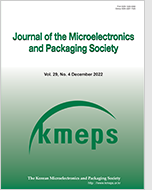
Search
- Past Issues
- e-Submission
-

KCI Accredited Journals KCI 등재지
KCI Impact Factor 0.54
Editorial Office
- +82-2-538-0962
- +82-2-538-0963
- kmeps@kmeps.or.kr
- http://kmeps.or.kr/

KCI Accredited Journals KCI 등재지
KCI Impact Factor 0.54
Journal of the Microelectronics and Packaging Society 2024;31(4):103-108. Published online: Jan, 22, 2025
DOI : doi.org/10.6117/kmeps.2024.31.4.103
With the recent advancements in the wearable electronics industry, the field of flexible devices is rapidly expanding, leading to extensive research on their mechanical reliability. Generally, the properties of metal thin films are measured using nanoindentation techniques, but in the case of flexible devices, these properties tend to be underestimated due to the influence of the substrate. In this study, the contact area function was determined to measure the nanohardness as a function of depth for thin films deposited on flexible substrates. Copper (Cu) thin films with a thickness of 1 μm were deposited on polyimide (PI) substrates using sputtering, and nanoindentation experiments were conducted up to a maximum depth of 300 nm. Based on the assumption that the mechanical properties and the size of the indentation under the same load are identical, the contact area function for Cu/PI specimens was determined using results obtained from Cu films deposited on Si wafer substrates. The nanohardness as a function of depth was calculated to observe the substrate's influence at varying indentation depths. Furthermore, finite element analysis was performed to identify the range of stress fields beneath the indenter across the thin film and the substrate.
Keywords Nanohardness, Nanoindentation, Thin film, Flexible substrate